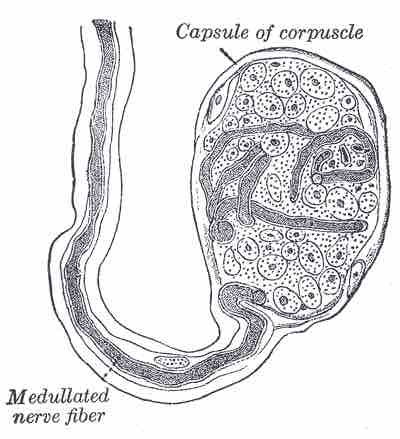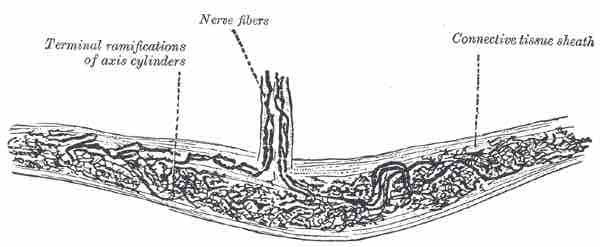Thermoreception
Thermoception or thermoreception is the sense by which an organism perceives temperatures. The details of how temperature receptors work are still being investigated. Mammals have at least two types of sensors: those that detect heat (i.e., temperatures above body temperature) and those that detect cold (i.e., temperatures below body temperature). A thermoreceptor is a sensory receptor or, more accurately, the receptive portion of a sensory neuron that codes absolute and relative changes in temperature, primarily within the innocuous range. The adequate stimulus for a warm receptor is warming, which results in an increase in their action potential discharge rate; cooling results in a decrease in warm receptor discharge rate. For cold receptors, their firing rate increases during cooling and decreases during warming. The types of receptors capable of detecting changes in temperature can vary.
Types of Thermoreceptors: Capsule Receptors
Some of the receptors that exhibit the ability to detect changes in temperature include Krause end bulbs and Ruffini endings. Krause end bulbs are defined by cylindrical or oval bodies consisting of a capsule that is formed by the expansion of the connective-tissue sheath, containing an axis-cylinder core . End-bulbs are found in the conjunctiva of the eye, in the mucous membrane of the lips and tongue, and in the epineurium of nerve trunks. They are also found in the penis and the clitoris; hence, the name of genital corpuscles. In these locations, they have a mulberry-like appearance, being constricted by connective-tissue septa into two to six knob-like masses.

Krause end bulb
A drawing of a Krause end bulb receptor which can detect cold.
The Ruffini endings, enlarged dendritic endings with elongated capsules, can act as thermoreceptors . This spindle-shaped receptor is sensitive to skin stretch, contributing to the kinesthetic sense of and control of finger position and movement. Ruffini corpuscles respond to sustained pressure and show very little adaptation. Ruffinian endings are located in the deep layers of the skin where they register mechanical deformation within joints as well as continuous pressure states.They also act as thermoreceptors that respond for an extended period; in case of deep burn, there will be no pain as these receptors will be burned off.

Ruffini endings
A drawing of a Ruffini ending receptor which can detect warmth.
In addition to Krause end bulbs that detect cold and Ruffini endings that detect warmth, there are different types of cold receptors on free nerve endings.
Types of Thermoreceptors: Free Nerve Endings
There are thermoreceptors that are located in the dermis, skeletal muscles, liver, and hypothalamus that are activated by different temperatures. These thermoreceptors, which have free nerve endings, include only two types of thermoreceptors that signal innocuous warmth and cooling respectively in our skin. The warm receptors show a maximum sensitivity at ~ 45°C, signal temperatures between 30 and 45°C, and cannot unambiguously signal temperatures higher than 45°C; they are unmyelinated. The cold receptors have their maximum sensitivity at ~ 27°C, signal temperatures above 17°C, and some consist of lightly-myelinated fibers, while others are unmyelinated. Our sense of temperature comes from the comparison of the signals from the warm and cold receptors. Thermoreceptors are poor indicators of absolute temperature, but are very sensitive to changes in skin temperature.
The Thermoreceptor Pathway
The thermoreceptor pathway in the brain runs from the spinal cord through the thalamus to the primary somatosensory cortex. Warmth and cold information from the face travels through one of the cranial nerves to the brain. You know from experience that a tolerably cold or hot stimulus can quickly progress to a much more intense stimulus that is no longer tolerable. Any stimulus that is too intense can be perceived as pain because temperature sensations are conducted along the same pathways that carry pain sensations.